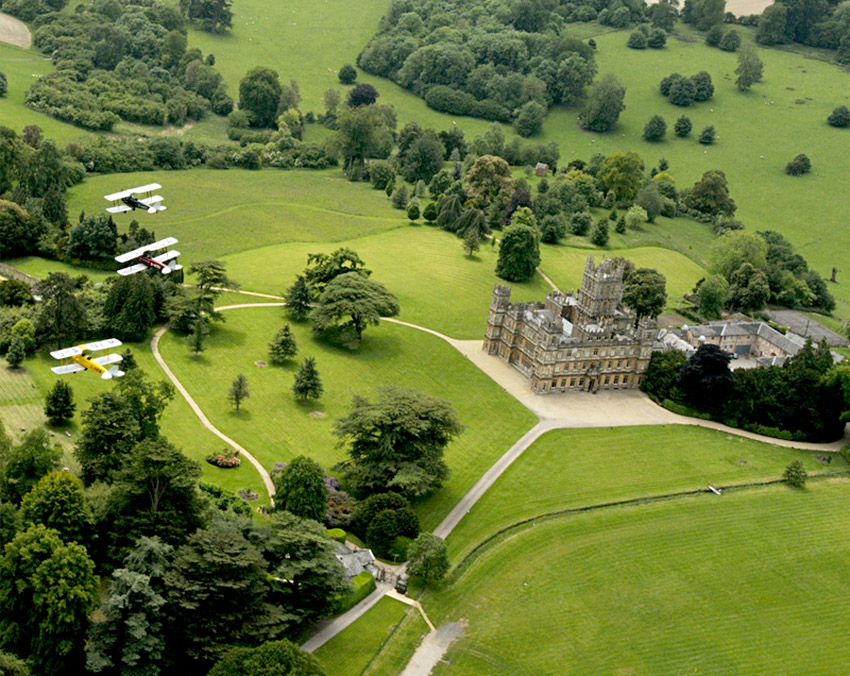
I was a passenger in one of the Tiger Moths in the above photograph. We flew over Highclere on a beautiful day, it was really a practice flight, a reconnaissance journey for flight lines and future plans.
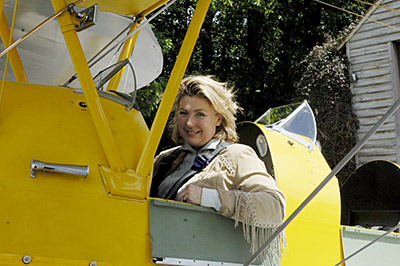
Over 70 years ago, during World War II, many planes crashed in the Estate around Highclere Castle. One of the reasons that planes crashed around the hills here was because of sudden adverse weather. The “lost planes”, the “lost men” did not enjoy our lovely, sunny day. They may well have trained in the clear, dry skies in the USA, however, the UK is rather better known for rain and fog.
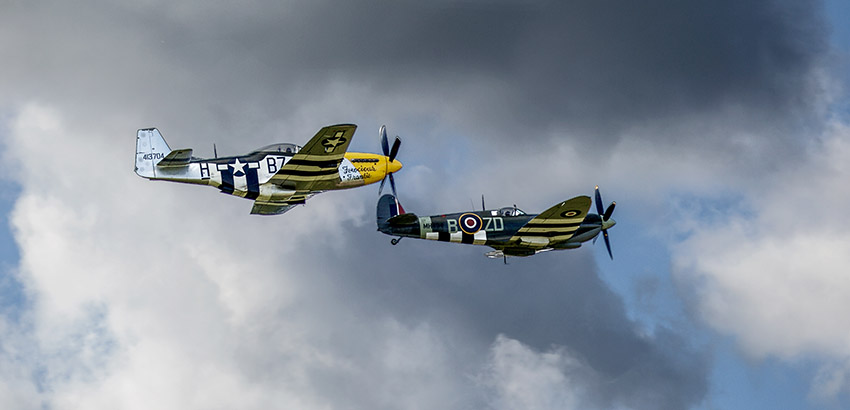
On May 5th 1945, just three days before the end of World War II, seven young men climbed into a B-17 from 326th Squadron and took off from RAF Podington. 1st Lt Reginald Hammond, 1st Lt Robert Sprout, 2nd Lt William J Dutton, T/Sgt Jacob Buikema, S/Sgt Daniel Minkon, 2nd Lt John Duffy and the radio controller Lt Len Nitti. The synopsis of their story was that, lost in poor weather and limited visibility (just as today), the B-17 circled twice over the Castle and then headed south. They hit the trees on Sidown Hill, tumbling into flames and wreckage. All on the Estate rushed up the hill to help, but only one man survived -Lt Len Nitti. Both Patti and Mary Nitti have been in touch with us and I hope may join us in September. We would welcome any of the other airmen’s descendants too. Paul McTaggart from Highclere also found a photograph of the plane – it is in a diner in Fort Worth, Texas.

The B-17 Crew
On the 15th May 1944 Lt Thomas Dee Stewart, a young American pilot from Nevada, flying a P38, from the 402nd squadron of the 370th Fighter Group, crashed through clouds into another plane and plunged straight down into a bluebell wood. His relative Jessica, found his name on this blog and contacted us and we have since held a service where he died. The vivid green grass, cerulean carpets of scented bluebells leads you through the dappled light under the beech trees to this glade, now a place of memories and peace.
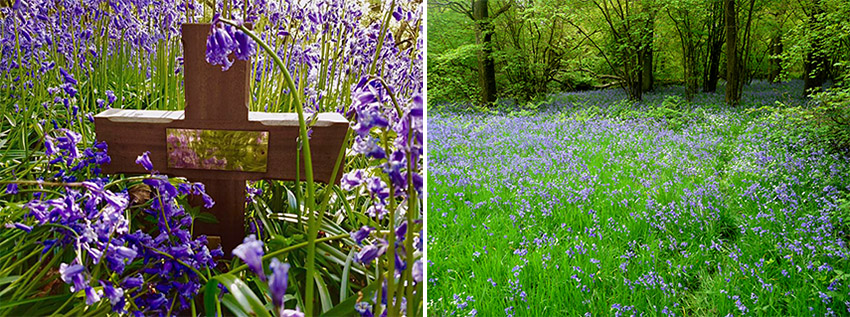
The glade with the memorial to Lt Thomas Dee Stewart
A Lysander crashed into a bank whilst practicing shooting out search lights with Lt Tom Consitt and AF Albert Clarke …. It was a compact plane and used by the UK, Indian and Canadian Air Forces. A Proctor, flown by S/LT Thomas Finlayson RN crashed by Maple Farm. Two Mosquitos crashed with a UK crew (F/Lt David Campbell and F/Lt Kevin Dodrill) F/O Geoffrey Rolph and Sgt John Newton) and a Canadian crew member on board. The mosquitos were made of wood and very fast.
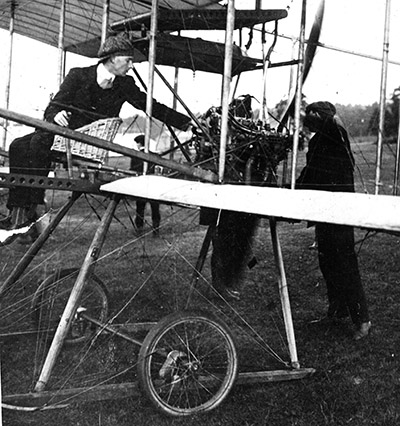
Geoffrey de Havilland in his aircraft
Like the Tiger Moth, this plane was also designed by Geoffrey de Havilland who in fact made his first flight from Highclere in 1910. He designed a series of planes the Gipsy Moth, Moth Major, Hornet etc
De Havilland’s first flight in September 1910
An Armstrong Whitworth Whitley crashed along the edge of the beech trees flown by a New Zealand pilot from Rotarua called F/O Robert Ewert NZAF, his crew was F/O Geoffrey O’Connell RAF, Sgt Egbert Waterman RAF and FS John Westfield and we think a P47 Thunderbolt has yet to be found.
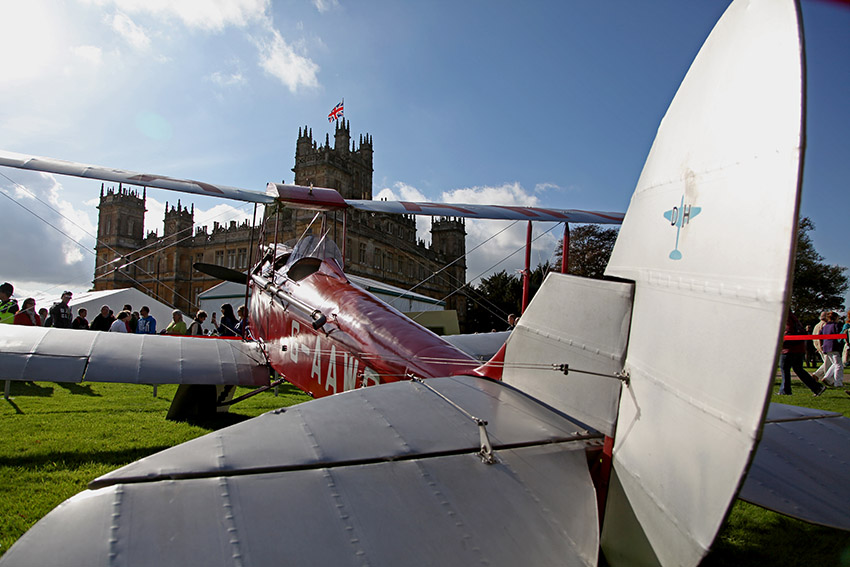
Planes such as this will join us for our September weekend
Early aviation led to many injuries if not death and of course in World War I airmen were sent to Highclere as patients. Remarkably, Almina saved both lives and limbs. Whilst the airmen who died here are from a later war, it is again putting names and stories together so they shall not be forgotten.
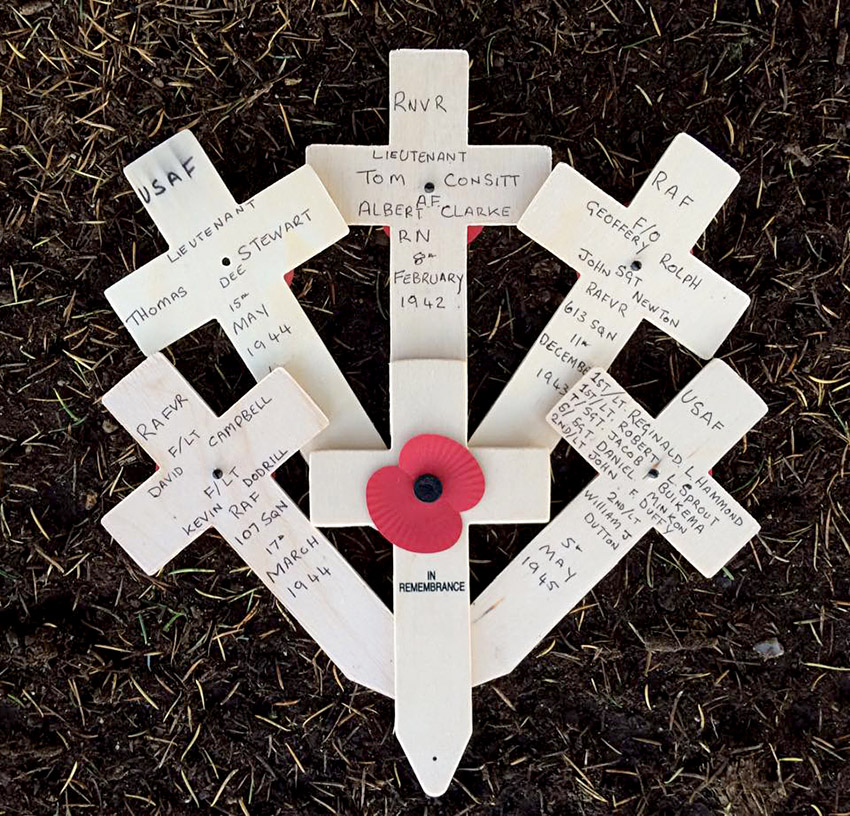
Here are some of our heroes
One project for me for this June, is to create an exhibition around the stories and the aeroplanes to share in September. I have a feeling as ever that I will start off with enthusiasm but find it is a far larger project than I ever imagined, but I hope it will prove to be a fitting legacy to Those Magnificent Men in their Flying Machines.








 Instagram
Instagram
What a lovely tribute! Thanks so much for sharing. I bet you thoroughly enjoyed flying in that little Tiger Moth…I had a similar experience in an open-cockpit Stearman. It had a hoe handle for a stick and duct tape on the wings. We flew over a hayfield where hay was being baled. I remember the sweet smell of the hay.
Perhaps this will turn into a larger project than envisioned — but I promise to read it. Please do write about these aviators!
Kevin Sean Dodrill I see, my grandmother’s brother. He was always referred to by her as, ‘our paddy’
It is an honour to read about these brave men who gave their lives for us. We lost a family member in an air crash in WWII too, somewhere over France I believe, and remembering them and how brave they were gives great pride.
Lady Carnarvon, thank you for all your work at Highclere, but most esp cially remembering these pilots and crewmen from “the greatest generation” who offered their lives in protecting all of us. Here in the US, there are a number of organizations dedicated to memoralizing those men and women who gave their lives in defense of their country, also keeping the lessons of WWII “alive” for following generations. Recognizing them and their families is an extremely worthy calling. Thank you for the pictures and stories and your dedication to WWII aviators. You have our greatest respect.
I hope to link up with some USA charities – I am trying to figure out the best direction!
I hope, if you do another tour of the US Northeast, you’ll post it on your site. I would hate to miss you. Didn’t know of you and this site when you were in Westport, CT last time.
It was an extraordinary time – and I think of Highclere as having a big heart
This indeed is a huge project but I’m sure you will succeed. My husband and I attended the Proms and Heroes of Highclere Day in 2014. My husband is a old plane enthusiast and thoroughly enjoyed watching the B17 and other planes flying over Highclere. Wish we could join you again this year but we live in Phoenix, Arizona.
By remembering all the brave men and women who gave their lives in both wars , those “lost planes and lost men ” will never be forgotten.
Lady Carnarvon, your dedication is truly an inspiration to the relatives of those who died and all of us.
Thank you again for another wonderful story of life at Highclere.
Thank you
Beautifully written,as always, Lady C.
What wonderful trubutes to our fallen heroes
Thanks for your thoughtful work and study. Brings tears to my eyes.
From Omaha,(not the Beach)
I enjoyed my visit to Omaha!!
Lady Carnarvon,
We are looking forward to coming in September and I have a small fund-raising idea which I would like to share with you if I may or should I direct it to the sponsorship email addresses provided at the bottom of the Heroes at Highclere page?
Always a pleasure reading your Blog,
Heather
Please do go through Charlotte’s email – it will reach me – it is just a few of us here seeing what we can do
What a wonderful event you are planning for September to honor these heroes, but also to pay tribute to today’s warriors, the wounded, and the caregivers. I am spreading the word to my friends in the States, hoping a few may be able to join me for Heroes at Highclere. ‘Would love to be present in the morning on Sunday, Sept. 9, to see the unveiling of the commemorative statue, and also participate in the many planned activities and exhibits. My cousin flew in Afghanistan with the US Air Force and he is a real military planes buff. Another guy who flew with the British Army Air Corps, and whom we might encourage to attend, (though he is a bit busy with wedding plans at the moment), and he might be able to organize one of his “Walking with Warriors” around the woods and grounds of Highclere.
Hoping that Henry Charles Albert David, might be able to be there in September? After all, there is an old tradition of having the Prince of Wales at Highclere 🙂
All the best for a most successful tribute for the “Heroes of Highclere”!
Thank you – I hope you can come and I hope I can share behind the scenes, we can walk though the woods to find the glades of memories. Whatever Highclere can do
Thanks for sharing..somber reading for sure.
Lady Carnarvon, thank you so much for sharing this history. I know the family’s that lost their loved ones appreciate all the hard work that went into your research. I love getting these stories of history, and life at Highclere.
Thank you – I thought I would begin to share what I know about the airmen on the Community page on this blog. In some cases I have more details about their family
Thank you very much for sharing with us. It’s brilliant and specially for their descendants to keep this with them. They can be proud of this magnificent crew.
Thank you for this wonderful memorial.
I hope you are well?
Grazie per averci raccontato questo pezzo di storia…io vivo in italia ma amo leggere e studiare la storia d’Inghilterra e soprattutto adoro le ue storie!grazie mille…
Once again proving what a proper steward you are of the history of your house.
Good day Lady Carnarvon, I love this entire project your taking on. I’d like to suggest a few American organizations for you to connect with. First is the families of WWII, http://www.familiesww2veterans.org/ and the second would be the World War II museum in New Orleans, Louisiana https://www.nationalww2museum.org/about-us
Hope these will give you more access to stories and knowledge beyond what you already know. Wish I could join you in September, but alas no capability. Might I suggest you contact a film crew to create a documentary of the event and capture the stories?
I think it would be an amazing and moving story for a documentary, both of the course of the war and of these men ..
Hello Lady C,
A wonderful tribute to Wilbur and Orville Wright who flew the first plane in Kitty Hawk, North Carolina. I wish they could now walk through the emerald carpets of the meadows of Highclere and say “well done”.
Sringara
The first powered flights in the US were I think in 1903 – de Havilland read about them and constructed his plane from such research. He had never seen a plane fly – is that not amazing? A different world
That is the most beautiful picture I have seen of your “grounds”!!! What an amazing tribute – your history keeping is a joy to read – Love it!!!
Thank you for this remembrance. I was surprised to see a pilot from Nevada. I wish I could ask my dad if he knew him. He might have since they were both Army Air Force pilots in 1944. In those days there was a very small population in Nevada most of whom were centered in the Reno area where I was born. Las Vegas was barely a speck on the map then. Nevada is still a large expanse of desert where atomic testing was done. My dad was present during several of these tests. His health issues later in life were in no way connected with these tests, surprisingly. Nuclear weapons testing at the Nevada Test Site began with a 1-kiloton-of-TNT (4.2 TJ) bomb dropped on Frenchman Flat on 27 January 1951.
I feel this remembrance is a tribute to all men and women who were enlisted to fight for freedom during WWII. Thank you again.
Thank you so much for your lovely spirit that seeks to honor those who gave all for the freedoms we enjoy, and perhaps some take for granted in today’s busy world. With a father and a nephew, and many cousins who have given their life’s work to the USAF, those magnificent men hold a dear place in our families hearts to this day. My nephew is currently at Joint Base Andrews in Washington. Voted several years in a row as Volunteer of the Year there, I’m forwarding him your post and asking him what his suggestions would be for a proper charity group that might deserve your consideration. At Joint Base Andrews in Washington, they have great displays of all of the older flying machines, whether made here in the USA, or by our allies across the pond. They also maintain detailed records of all of the women and men who gave all for our British brothers and sisters which include photographs and medals awarded to the living, and to those who gave their lives in the line of duty. If you are ever in Washington D.C. , I highly recommend an escorted tour of JBA. They are always ready and willing to share photos, stories, and displays there, which document how the RAF and the USAF worked so closely together during WW2. I’m glad that their historical staff will now know of your plans, if they don’t already. Perhaps they can be a resource in your plans to honor our troops at Highclere or help fill in any blanks that might pop up during your research. Again, thanks Lady Carnarvon, for your tireless efforts to improve our futures, while honoring the past, with Highclere as the beautiful backdrop, and now an even more important place in our hearts here in the USA.
I hope US air, men might join us! Carpe Diem
It’s not well known that my favorite author, Nevil Shute (Norway) had an airplane factory in Piccadilly, York (near you?). He helped design planes in the 20’s and 30’s working for Vickers. He published without his last name because he didn’t want his investors thinking he didn’t spend full time designing and testing new planes. For the time, his planes were the fastest available. My favorite all-time book is his “Trustee from the Tool Room.” Typical of some of his books, it ends with a clever, charming twist.
Dear Lady Carnarvon
Please tell me your dates for this event in September, I may be able to get my Mom to come with me. Then the date of the B17 crash should be May 5, 1945.
Respectfully
Randy Sprout
Thank you
Could you please tell me the dates of your memorial event in September?
Heroes at Highclere is on 8th and 9th September
You are such an amazing person. Thank you for not only this meticulous documentation, which brought tears to my eyes, but for all of the other countless things you do to make this world a better place. You are appreciated and loved!
Thank you but it is really everyone here who gets it…
Thank you Lady Carnarvon. It is as I expected. A failed mission of such personal importance. Prayers for all.
Dear Lady Carnarvon,
I am so moved by this event you are planning. You see, my husband is a Vietnam Veteran. He and I were so rebuked upon his return that we felt ashamed of his service to our country. We are getting past it now thanks to a few events to honor the service of Vietnam Veterans. This is the reason I want so desperately to attend your event. Who knows? Maybe God will make a way! I know it is primarily for the World War Veterans, but all military service is honorable when it is given to serve their country. The fact that you appreciate this fact is very meaningful to me.
I want to thank you from the bottom of my heart for what you are doing. I am sure it is a huge undertaking to manage. I wish I lived in the UK so I could volunteer to help.
I also want to thank you for replying to my comment last week. It meant so much to me.
God Bless you and your generous heart.
Sue Smith
Englewood, Florida
Dear Linda,
This event is for you and your husband as much as anyone. It is just thinking about what it is to serve and save …we have done it and you have done it
What a wonderful project and a fitting tribute to the men lost at Highclere. I’m Amy Hinote’s mother (we were there for Mother’s Day tea in March and I believe you are scheduled to speak at her conference next year). My father and son (Amy’s grandfather and brother) have served as US Air Force pilots so this remembrance is especially meaningfull to us.
Thank you!
Thank you and I am looking forward to the talk! Please share what we are doing! I am back to Winnie the Pooh “You can’t stay in your corner of the Forest waiting for others to come to you. You have to go to them sometimes”.
Thank you for actually listing the names of these brave heroes. I think it’s important that people, other than just family members, remember them. Your blog brings out a different emotion in me every week. This one has me tearing up, but your story about the rain and your castle manager saying “Living the dream, Lady Carnarvon, living the dream.” had me literally laughing out loud all by myself. I even had to close my laptop to cry alone while reading your entry about refugees. Thank you so much for all the love you’ve put into Highclere and for opening it up to the rest of the world.
Thank you for another beautiful writing. I am humbled by your constant work to honor and remember those who have served, and indeed, those who continue to serve. My grandfather served in pastoral care from the US in WWI, and my father served as a doctor in the mobile army medical corp behind Patton’s troupes in WWII. One of my brothers, who passed away in a climbing accident, was involved in crucial research for the Veterans Administration in the treatment of PTSD. I truly realize the sacrifice that so many men and women have made in service to their countries. Your dedication to their memory is appreciated beyond words. I hope to make it to Highclere for the celebration on the 8th September, and to walk in the woods to the markers, to see the rooms set up as hospital treatment areas, and to just once more take in the beauty, the grace, and the history of Highclere.
Thank you from the bottom of my heart for keeping the memories of sacrifice alive. May 1st tomorrow. May it be a lovely month.
Thank you, and I have followed some of the Veteran papers. How amazing – General Patton was here at Highclere in June 1944, but my own grandfather knew him too and my father played “toy soldiers with him”!
I agree – here is to May!
We owe our blessings and way of life to these brave souls who gave so much and in these cases, their all. When will the powers that be learn the lessons we are shown over and over? The word “hero” gets bandied about too easily but it’s the only word to describe these folks. Thank you for what you’re doing, Lady Carnarvon.
What a wonderful gesture! I am sure that the families of the flyers – among other attendee – will be moved.
I enjoy your blog very much. You are a delightful person and it shows.
Thank you so much for the continued work you do to benefit others. You and your team constantly go above and beyond the norm when it comes to sharing your wonderful home and its history. You also work so tirelessly for our military members and other charities like PBS. As someone earlier posted, you are a wonderful steward of all that you have and so generously hare with others. Many blessings to you!
Thank you !
Dear Lady C. Thank you for the stories on the planes and men who were so brave to serve their country.
Robert Sprout is my Grandfather I never met. Thank you for honoring him. It means a lot to me. He is about to be a great grandfather for the second time, and it is still heartwrenching all these generations later.
If you have any more information – letters or photos would it be possible to see them? To create a sense of the man – his life?
Yes we can send you some. Where should we send it to?
Dear Lady Carnarvon,
Could you please provide me with an e-mail to get you some of the letters and photos for “this Man’s” life. Robert L Sprout.
Respectfully,
Randy Sprout
Randy – that would be lovely. Please send them to [email protected] and they will get to me.
Lady Carnarvon, Laurel, the Granddaughter of Robert Sprout, is the daughter of Randy Sprout, who also posted above. Randy Sprout is the son of Robert Sprout, 1st Lieutenant on the plane that went down on May 5th, 1945. His Mother, that he mentioned was the wife and widow of Robert Sprout. It would be nice if you could provide him with more details of the event, so that he and his Mother could make plans to attend. If you are interested in getting a sense of who Robert Sprout was, you can’t get any closer than Randy and his Mother.
So very, very interesting and sad. Thank you Lady Carnarvon for the wonderful write ups! Wishing we lived closer than California….
Dear Lady Carnarvon,
Once again your blog tugged at my heart. My dad taught navy pilots to fly during WW2 in Corpus Christi and then moved to Reno, Nevada with my mom to finish college. He loved flying and even ended up teaching my mom to fly.
I was on a Viking River Cruise in 2012 ( on my honeymoon) that went to Normandy. They gave us all a rose to place upon the cross of a soldier. I took a picture of the name of the young man I found and laid my rose on his grave and took a picture. When I got home I looked him up on the internet starting with an on line phone directory since I had his name and town he came from. One sight led to another and as I dug deeper and deeper I found that he had been posthumously awarded The Purple Heart for whatever heroics he had performed that fateful day on the beach in Normandy. I eventually was led to a website that showed where he was buried so I posted the picture I had taken of his cross at Normandy and thanked his family for his service. I am sure no one ever saw it posted but I was glad to know something of the young nineteen year old that bravely gave his life for all of us.
Thank you for remembering all of these grave men and for bringing them back to life for all of us to honor and respect.
All the best always,
Diana
Dear Lady Carnarvon,
I was so very impressed with “Heroes at Highclere”! Your personal efforts to honor my Dad’s crew and all the Airman was so very apparent. I showed my 93-year-old Mom the high definition video of the event and she also was very thrilled. I wanted also to tell you what a prince you have in Paul McTaggart! He took all the family members to the wreck site and that was stunning for all of us. I showed my 3 children the video of us hunting for flack of the plane and that really brought this personal history home to them. Paul’s research into this event is so sensitive and so thorough. Thank you and your staff for a truly memorable event. It really means a lot to people you haven’t even met!
Dear Lady Carnarvon,
Thank you so much for the work you have done to highlight the Heroes at Highclere. We are the family of Flight S/Lt Thomas W Finlayson of the Fleet Air Arm, who tragically lost his life in an accident flying the Proctor, at the grounds of Maple Farm, described above.
Some of the family are intending to visit Highclere on 13th July 2020 and would be grateful if you could provided us with a contact (possibly Steve or Paul, who you mention in a separate blog) who might be able to provide us with some details and if we might be able visit the site in order to lay a small tribute. My father is the last surviving sibling.
Kindest regards
Helen Tait (nee Finlayson)
Thank you for this and all your work. I’ve just been contacted by your Aircraft History team and Kevin Dodrill (my Great Uncle) my Dad has always honoured his memory each November and now we have a place to visit.
I have gathered from Paul Mac – i hope you will join us in May May 8th Ve day
A very interesting read..Thankyou all contributers
Hi after a recent visit to Highclere by coach which we had an excellent time walking around the house and gardens. I didn’t know about the aircraft crashes on the estate and being interested in military aviation history I will try to find out more about the aircraft and aircrew involved
Regards Nick Hagley.
Thank you we will post more as we work towards our history festival this autumn!
LT Reginald Hammond would have been my uncle.
I served for more than 20 years in the US Army, and now I know where some of that desire to serve originated.
I hope to visit the area before I get too old to do so.